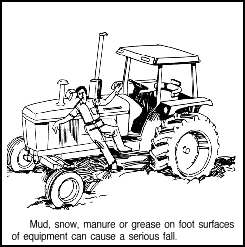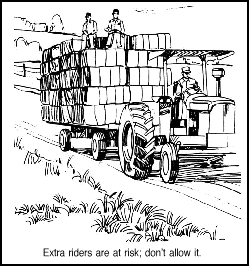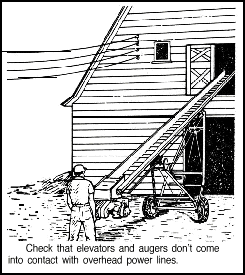All the steps involved in growing, harvesting and storing
grain crops require using equipment that has the potential
to injure a farmer who fails to follow safe operating practices.
There are several safety rules that can be applied to the
planting, harvesting, transporting, drying, and storing procedures.
Avoid operator fatigue - take frequent short rest breaks
if necessary. Don't take unnecessary chances when trying to
complete a job in a hurry.
Plan ahead - maintain machinery on a regular basis.
Check equipment before it is used.
Stop - if equipment becomes plugged or needs to be
checked, make sure that all moving parts have stopped and
that no one else can start the equipment while it is being
checked, cleaned, or repaired. Use 'lockout' procedures when
necessary.
Look - keep your eyes open and stay alert. Watch for
problems.
Listen - be sure you can hear what is happening. Wear
ear protection when operating equipment or working around
machinery.
Follow safe operating procedures - become familiar
with owner/operator manuals for all equipment that will be
used. Refer to the manual for adjustment and repair information.
Make certain that other workers use safe operating procedures.
Keep guards and shields in place - if guards and shields
are removed for maintenance or repair be sure to replace them
BEFORE the equipment is operated again.
Keep steps and walking surfaces clean - watch for mud, ice,
grease, and oil. Use handrails where provided.
Dress appropriately - wear reasonably snug fitting clothing
without torn or frayed edges. Avoid jackets and sweat shirts
with draw strings, which may get tangled in moving equipment.
Wear protective clothing and gear - goggles, gloves, dust
masks, ear plugs, etc. should be worn whenever necessary,
not just when it is convenient.

Storage
Bin Safety
Storage bins present a multitude of potential hazards. Mold
and dust are common health hazards that can cause respiratory
damage. Entrapment in grain flow can cause death from suffocation.
Entrapment happens very quickly and results in more deaths
than injuries.
Falls from a grain bin roof or ladder can result in serious
injuries or death.
Common recommendations for grain bin safety include:
Never enter a bin where grain is flowing. Stop the flow and
shut off all automatic equipment and power.
Use lockout procedures when making repairs or when entering
the bin for any type of inspection.
Never enter a grain bin alone. Always make sure someone knows
where you are. If possible, have two people available to help;
one can go for help while the other person helps you. If you
are helping, do not jeopardize yourself if you cannot safely
rescue the other person.
Attach ropes inside the bin and use a harness if you must
walk on the grain. Many farmers have died after falling through
a crust of spoiled grain and were buried in the loose grain
underneath the crust.
Make sure a storage bin is well ventilated before entering.
Wear a respirator to protect against dust and mold.
If trapped, but not buried, stay near the outside wall and
walk around the storage bin as the grain moves downward.
Keep ladders in good repair and free of slippery materials.
Seek professional help if servicing or repairing the electrical
or LP gas systems is necessary.


WHAT IS THE CMASH PROGRAM?
The Center for Michigan Agricultural Safety and Health (CMASH)
takes traditional Cooperative Extension Service farm safety
programs a step further by taking a holistic approach to improving
the health of the state's rural residents. Under CMASH, farm
safety is augmented with a program to assist healthcare professionals
in diagnosing and managing illnesses common to the farm industry.
The program is a joint effort of Michigan State University's
Colleges of Agriculture and Natural Resources, Human Medicine,
Osteopathic Medicine, Nursing and Veterinary Medicine, the Cooperative
Extension Service, Institute for Environmental Toxicology and
the Pesticide Research Center.
CMASH is not, a regulatory agency, it is an educational center
designed to encourage agricultural producers to protect themselves
from occupational injuries and diseases. Comments or questions
can be addressed to: Howard Doss, Extension Agricultural Safety
Specialist, MSU Cooperative Extension Service, 223 A.W. Farrall
Agricultural Engineering Hall,Michigan State University, Fast
Lansing, MI 48824.
Funding provided by the Michigan Agricultural Health Promotion
Project, a cooperative agreement among Agricultural Engineering,
the Cooperative Extension Service Agricultural Safety Program,
the College of Human Medicine and the National Institute for
Occupational Safety and Health.
Disclaimer and Reproduction Information: Information in NASD does not represent NIOSH policy. Information included in NASD appears by permission of the author and/or copyright holder. More